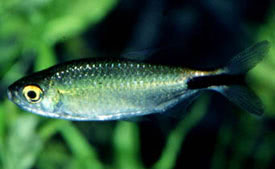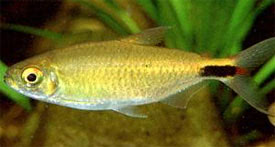
 Magyarul / Hungarian
Magyarul / Hungarian



- Scientific name: Bryconalestes longipinnis
- Synonyms: Brycinus longipinnis, Alestes longipinnis, Brycinus chaperi, Alestes chaperi
- Common name: Long-finned characin, African long-finned tetra
- Group: Characins
- Habitat: West Africa, Niger Delta, Ghana, Sierra Leone, Togo
- Size: 12-13 cm
- Biotope: In the Zaire (Congo) river basin
- Social behavior: A peaceful, schooling fish suggested for a large community tank
- Diet: Omnivorous, large live foods, large flakes
- Breeding: Hard
- Tank: Minimum 120 litres
- Population: 4-5 fishes for 120 litres
- Decoration: Sunlight, strong artifical lighting and a dull colored bottom, with dense vegetation are appreciated. Long-finned characins will not damage plants.
- Temperature: 24-26°C
- pH: 7-7,5
- Hardness: 10-12 NK°
- Lifespan: 3-5 years
Description: Shape: elongated body, very compressed sides, doras fin approximately in the middle of the body. The Long-finned characin have very large eyes. Alestes longipinnis have an olive green to yellow back, the sides are muddy yellow colored, with a beautiful silver sheen. The underside is silvery white. The rays of the dorsal fins are greatly extended on the male. The female has a crooked line along the back and a similar one along the belly; the dorsal fin does not have extended rays.
These lively, nimble swimmers need a lot of room. Good filtration is essential since the fish will not do well in a tank heavy with nitrates. Suggest water changes of one third the tank on a regular basis.
The breeding is hard. The female should be brought in breeding condition by feeding many times a day with great variety. When the 200-300 eggs are spawned, the parents must be removed, because they egg scatterer. After 4-6 days the eggs hatch and another 4 days later the young fishes are swimming free. You should feed the young fish with fine inforusia and a few days later with baby brine shrimp.



